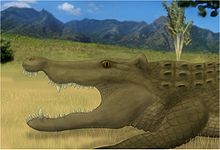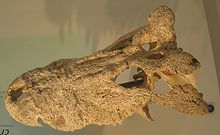- Voay
-
Voay
Temporal range: Late Pleistocene–Recent
Scientific classification Kingdom: Animalia Phylum: Chordata Class: Sauropsida Family: Crocodylidae Subfamily: Crocodylinae Genus: †Voay
Brochu, 2007Species - V. robustus (Grandidier & Vaillant, 1872) (type)
Synonyms Crocodylus robustus Grandidier & Vaillant, 1872
Voay is an extinct genus of crocodylid crocodilian. Numerous subfossils have been found from Madagascar, including complete skulls as well as vertebrae and osteoderms from such places as Ambolisatra and Antsirabe. The genus is thought to have become extinct relatively recently during the Holocene. It has even been suggested to have disappeared in the extinction event that wiped out much of the endemic megafauna such as the elephant bird following the arrival of humans to Madagascar around 2000 years ago.[1]
Skull of Voay robustus in the American Museum of Natural History
Its size, stature, and presumed behavior is similar to the modern Nile Crocodile (Crocodylus niloticus). Because Voay shared so many similarities with the Nile crocodile there must have been a great deal of interspecific competition for resources between the two crocodile genera if they were to have coexisted with one another. It has recently been proposed that the Nile crocodile only migrated to the island from mainland Africa after Voay had gone extinct in Madagascar.[2]
Description
One unusual feature of Voay that distinguishes it from other crocodilians is the presence of prominent "horns" extending from the posterior portion of the skull. They are actually the posterolaterally extended corners of the squamosal bone. Other related crocodilians such as Aldabrachampsus also had similar bony projections, although in Aldabrachampsus these projections were more like crests than horns.[3] Another diagnostic characteristic is the near-exclusion of the nasals from the external naris. It had a shorter and deeper snout than the extant Crocodylus niloticus, as well as relatively robust limbs. The osteoderms had tall keels and were dorsally symmetrical with curved lateral margins, running the entire length of the postcranial body.[4]
Voay robustus has been estimated to have obtained lengths up to 5 m and a weight of 170 kg.[5] These estimates suggest that V. robustus was the largest predator to have ever existed in Madagascar in recent times.
Phylogenetics
When Voay robustus was first described in 1872, it was originally assigned to the genus Crocodylus.[6] However, it is now known to have had more in common with the extant Osteolaemus, or dwarf crocodile, than Crocodylus. Some features it shares with Osteolaemus include a depressed pterygoid surface that forms a choanal "neck" on the palate. Because it was not close enough to be placed in the same genus as the dwarf crocodile, it was assigned to the new genus in 2007. Before this reassignment, the species was considered by some to be synonymous with Crocodylus niloticus. However, this was most likely due to a misinterpretation of remains from the living C. niloticus with V. robustus and the poor description of the original material from which the species was described.[7][8]
References
- ^ Brochu, C. A. (2007). Morphology, relationships, and biogeographical significance of an extinct horned crocodile (Crocodylia, Crocodylidae) from the Quaternary of Madagascar. Zoological Journal of the Linnean Society 150(4):835-863.
- ^ Bickelmann, C. and Klein, N. (2009). The late Pleistocene horned crocodile Voay robustus (Grandidier & Vaillant, 1872) from Madagascar in the Museum für Naturkunde Berlin. Fossil Record 21(1):13-21.
- ^ Brochu, C. A. (2005). A New Miniature Horned Crocodile from the Quaternary of Aldabra Atoll, Western Indian Ocean. Copeia 2006(2):149-158.
- ^ Hill, R. V. and Lucas, S. G. (2006). New data on the anatomy and relationships of the Paleocene crocodylian Akanthosuchus langstoni. Acta Palaeontologica Polonica 51(3):455–464.
- ^ Burness, G. P., Diamond, J. and Flannery, T. (2001). Dinosaurs, dragons, and dwarfs: the evolution of maximal body size. Proceedings of the National Academy of Sciences 98:14518-14523.
- ^ Grandidier, A. and Vaillant, L. (1872). Sur le crocodile fossile d'Amboulintsatre (Madagascar). Comptes Rendus de l'Académie des Sciences Paris 75:150–151.
- ^ Description of a skull of the extinct Madagascar crocodile, Crocodilus robustus Vaillant and Grandidier. Bulletin of the American Museum of Natural History 44(4).
- ^ Brochu, C. A. and Storrs, G. W. (1995). The giant dwarf crocodile: a reappraisal of ‘Crocodylus’ robustus from the Quaternary of Madagascar. In: Patterson, Goodman, and Sedlock, eds., Environmental Change in Madagascar. p. 70.
Categories:- Neogene crocodylomorpha
- Crocodylidae
- Pleistocene reptiles
- Holocene extinctions
- Endemic fauna of Madagascar
Wikimedia Foundation. 2010.

